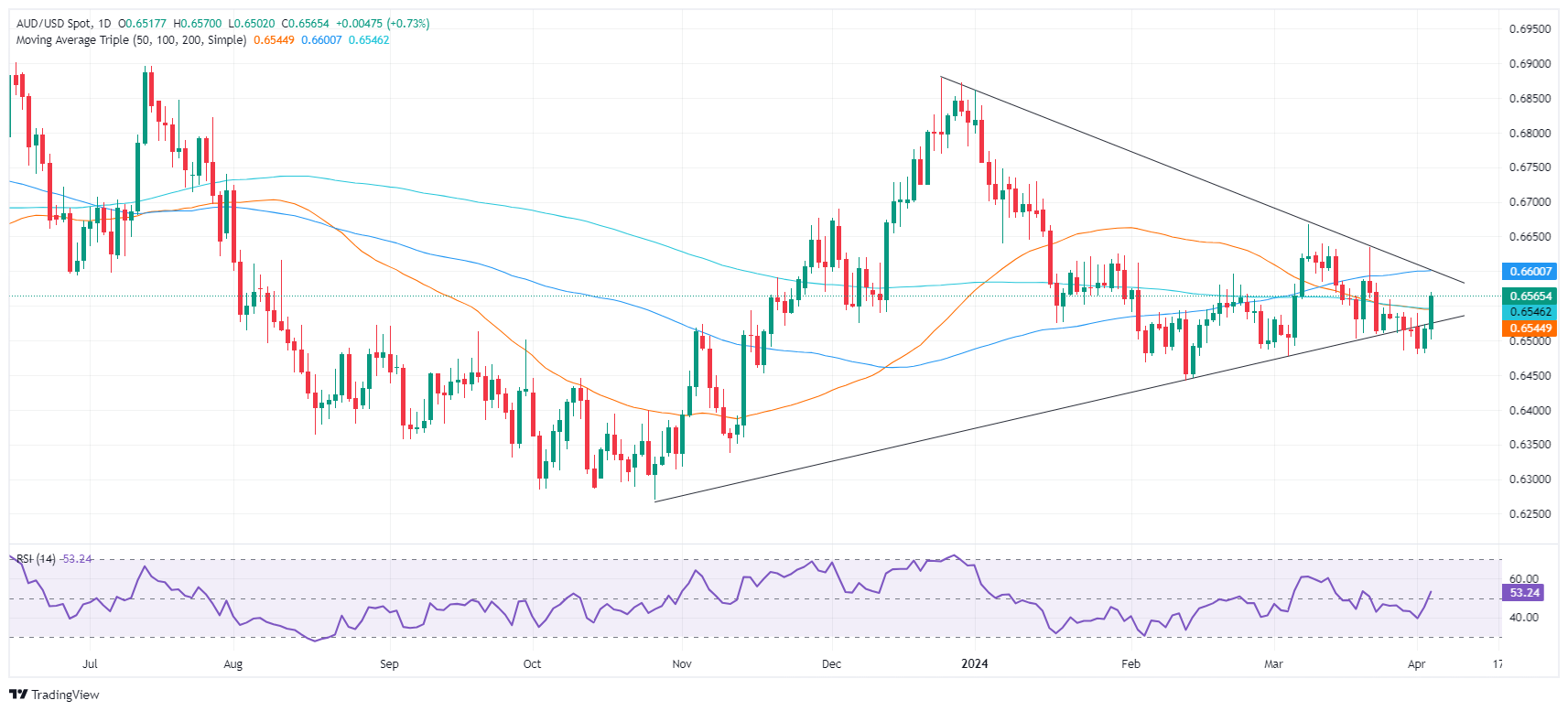AUD/USD gains against US Dollar on Fed race cut speculation, mixed data
- AUD/USD edges up, buoyed by Fed's rate talk and mixed US data.
- Fed's data-focused rate policy, strong US job market, and services data are headwinds for the US Dollar.
- Australia's services sector gains boost AUD amid global economic uncertainties.
The Aussie Dollar posted solid gains against the US Dollar on Wednesday, boosted by falling US Treasury yields and a soft US Dollar. Federal Reserve policymakers grabbed the headlines, while US economic data was mixed, with a strong ADP report but softer PMIs. The AUD/USD trades at 0.6565, posting minimal gains of 0.02% early during Thursday’s Asian session.
AUD/USD sees slight uptick as dovish Federal Reserve remarks and uneven US data fuel optimism in Forex markets
On Wednesday, the market was attentive to the remarks of Fed Chair Jerome Powell, who reiterated the US central bank's readiness to cut rates, albeit with a data-dependent approach. Atlanta Fed President Raphael Bostic's statement, supporting a rate cut in the last quarter of 2024, also drew significant attention.
Lately, Adriana Kugler, one of the newest Fed Governors appointed to the board, stated that the disinflation process would continue, and that would warrant lowering rates at least three times toward the last quarter of 2024.
The Aussie Dollar also benefited from an upbeat market mood as Wall Street snapped two days of losses. US Treasury yields finished flat, a headwind for the American currency. The US Dollar Index (DXY) tumbles more than 0.50%, down to 104.22.
Elsewhere, the March ADP report revealed that private hiring increased by 184K, exceeding estimates and forecasts. In the meantime, the US S&P Global and the ISM Services PMIs, were a touch softer.
In the meantime, Aussie’s data revealed the Judo Bank Services PMI improved from 53.5 in February to 54.4 in March. The report highlighted “This is the fourth consecutive month of improvement, with the services output index increasing by 8.4 points, the largest gain in the series outside of recovery from lockdowns.”
AUD/USD Price Analysis: Technical outlook
From a technical perspective, the AUD/USD shifted to a neutral-upward bias. A ‘bullish harami’ candlestick chart pattern, followed by Wednesday’s large candle breaching the 200-day moving average (DMA) at 0.6543, could pave the way to challenge the 100-DMA at 0.6597, ahead of the 0.6600 mark. The momentum has shifted in favor of the bulls, as the Relative Strength Index (RSI) turned bullish and aims higher.
On the other hand, a drop below the 200-DMA could expose the 0.6500 figure.
Australian Dollar FAQs
One of the most significant factors for the Australian Dollar (AUD) is the level of interest rates set by the Reserve Bank of Australia (RBA). Because Australia is a resource-rich country another key driver is the price of its biggest export, Iron Ore. The health of the Chinese economy, its largest trading partner, is a factor, as well as inflation in Australia, its growth rate and Trade Balance. Market sentiment – whether investors are taking on more risky assets (risk-on) or seeking safe-havens (risk-off) – is also a factor, with risk-on positive for AUD.
The Reserve Bank of Australia (RBA) influences the Australian Dollar (AUD) by setting the level of interest rates that Australian banks can lend to each other. This influences the level of interest rates in the economy as a whole. The main goal of the RBA is to maintain a stable inflation rate of 2-3% by adjusting interest rates up or down. Relatively high interest rates compared to other major central banks support the AUD, and the opposite for relatively low. The RBA can also use quantitative easing and tightening to influence credit conditions, with the former AUD-negative and the latter AUD-positive.
China is Australia’s largest trading partner so the health of the Chinese economy is a major influence on the value of the Australian Dollar (AUD). When the Chinese economy is doing well it purchases more raw materials, goods and services from Australia, lifting demand for the AUD, and pushing up its value. The opposite is the case when the Chinese economy is not growing as fast as expected. Positive or negative surprises in Chinese growth data, therefore, often have a direct impact on the Australian Dollar and its pairs.
Iron Ore is Australia’s largest export, accounting for $118 billion a year according to data from 2021, with China as its primary destination. The price of Iron Ore, therefore, can be a driver of the Australian Dollar. Generally, if the price of Iron Ore rises, AUD also goes up, as aggregate demand for the currency increases. The opposite is the case if the price of Iron Ore falls. Higher Iron Ore prices also tend to result in a greater likelihood of a positive Trade Balance for Australia, which is also positive of the AUD.
The Trade Balance, which is the difference between what a country earns from its exports versus what it pays for its imports, is another factor that can influence the value of the Australian Dollar. If Australia produces highly sought after exports, then its currency will gain in value purely from the surplus demand created from foreign buyers seeking to purchase its exports versus what it spends to purchase imports. Therefore, a positive net Trade Balance strengthens the AUD, with the opposite effect if the Trade Balance is negative.







